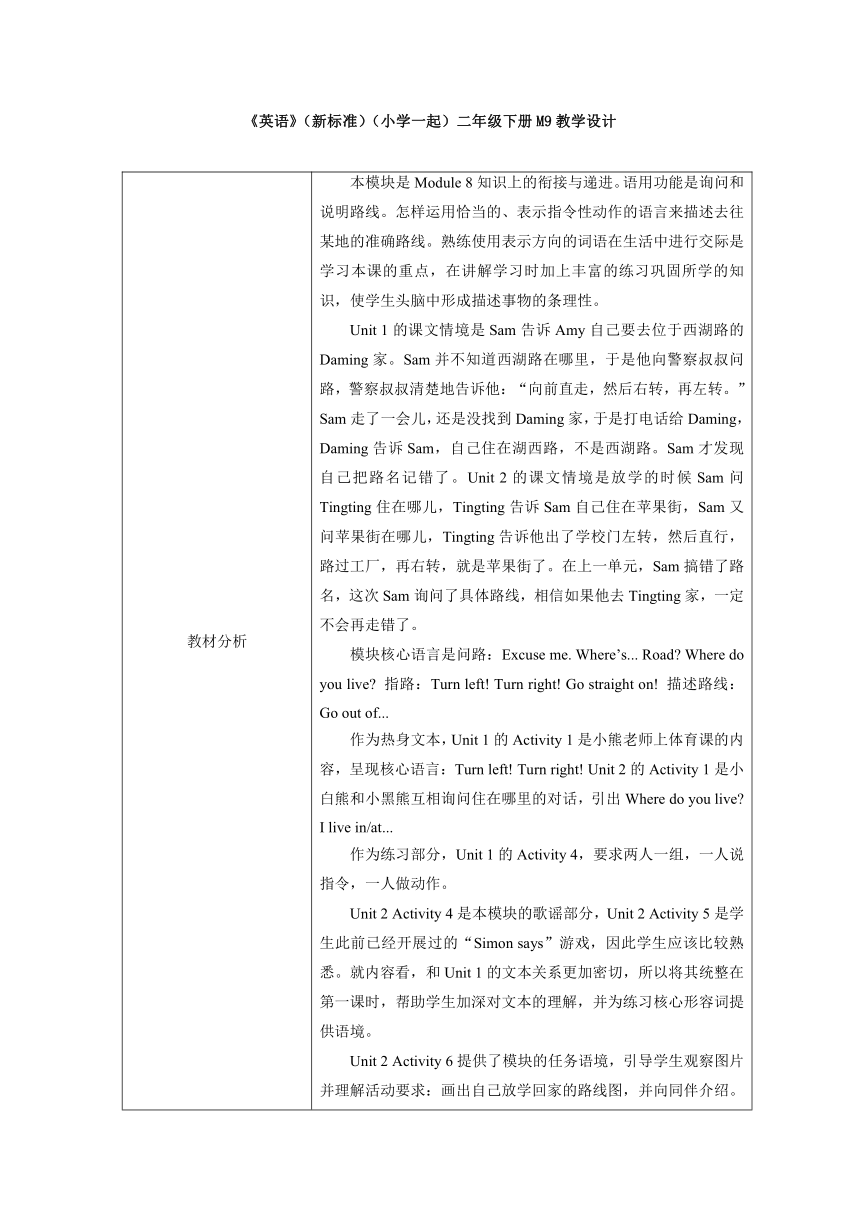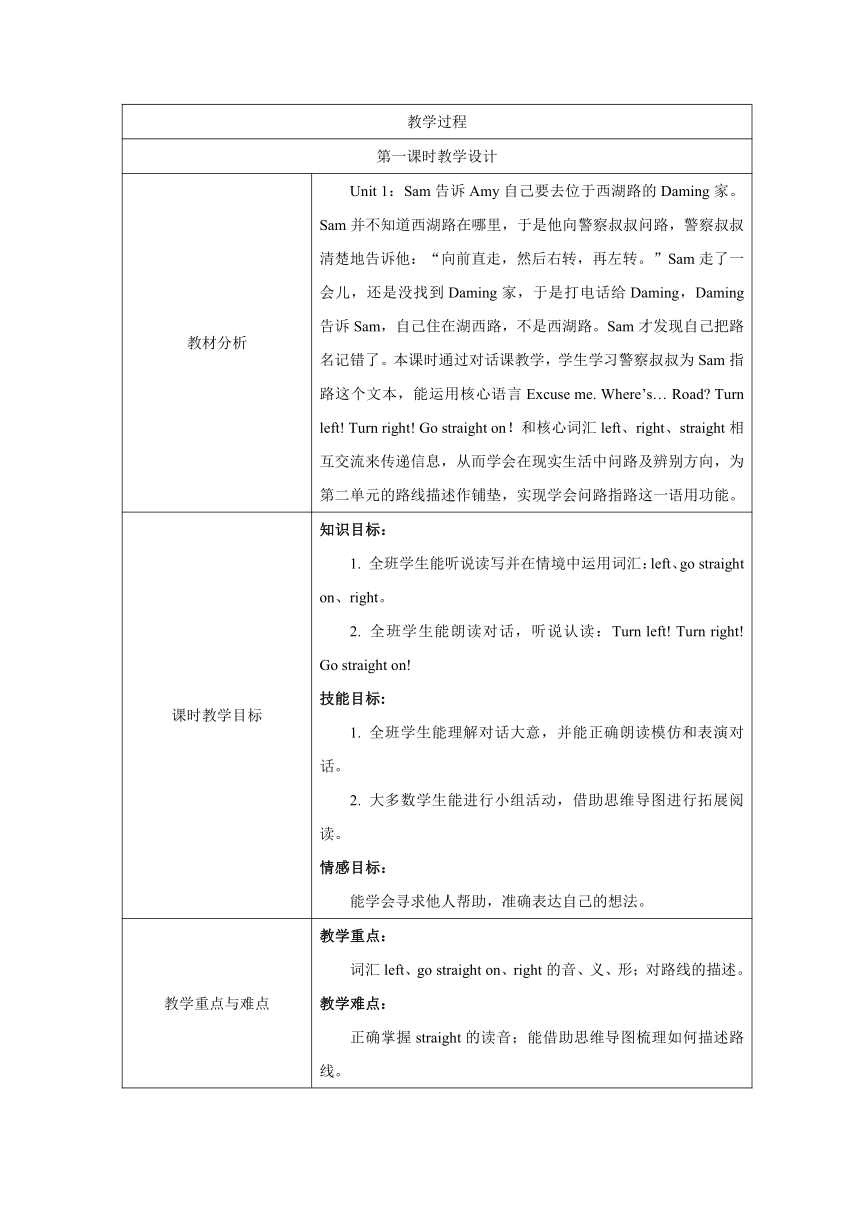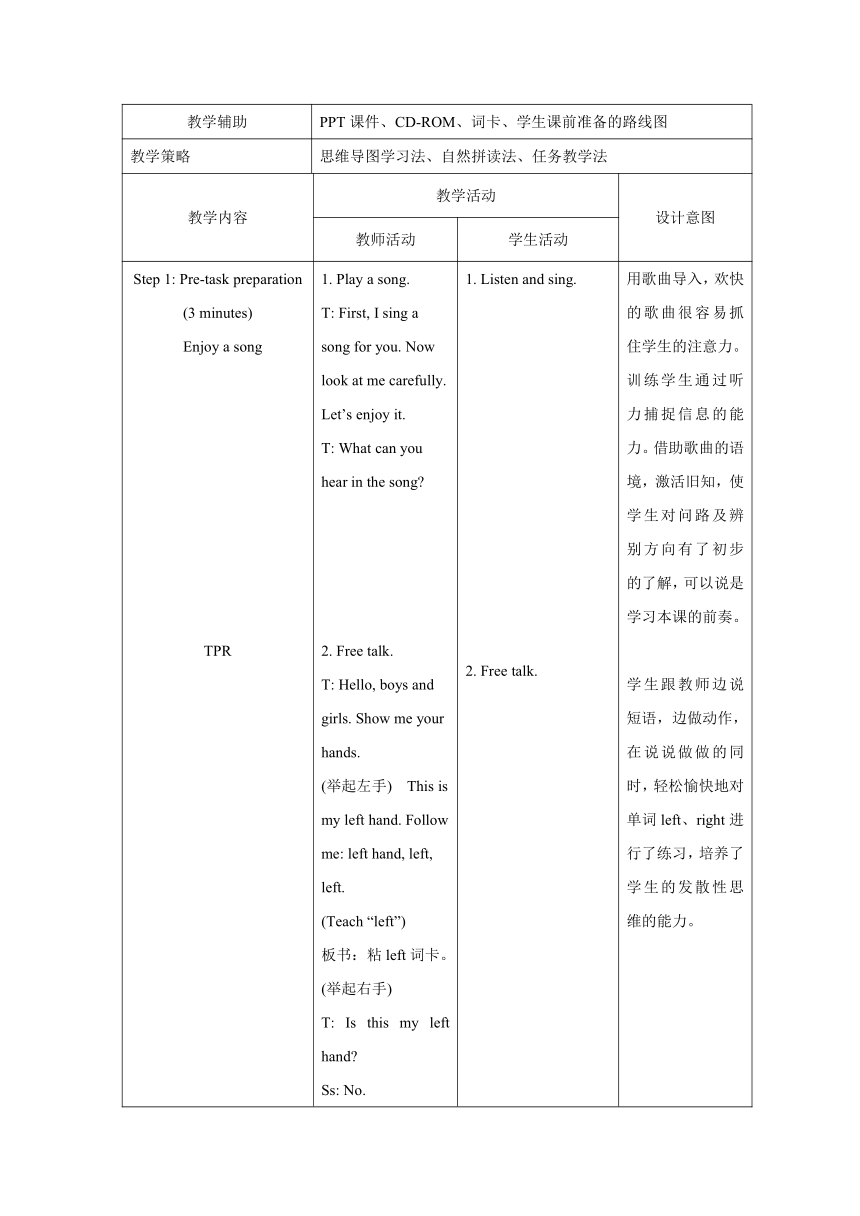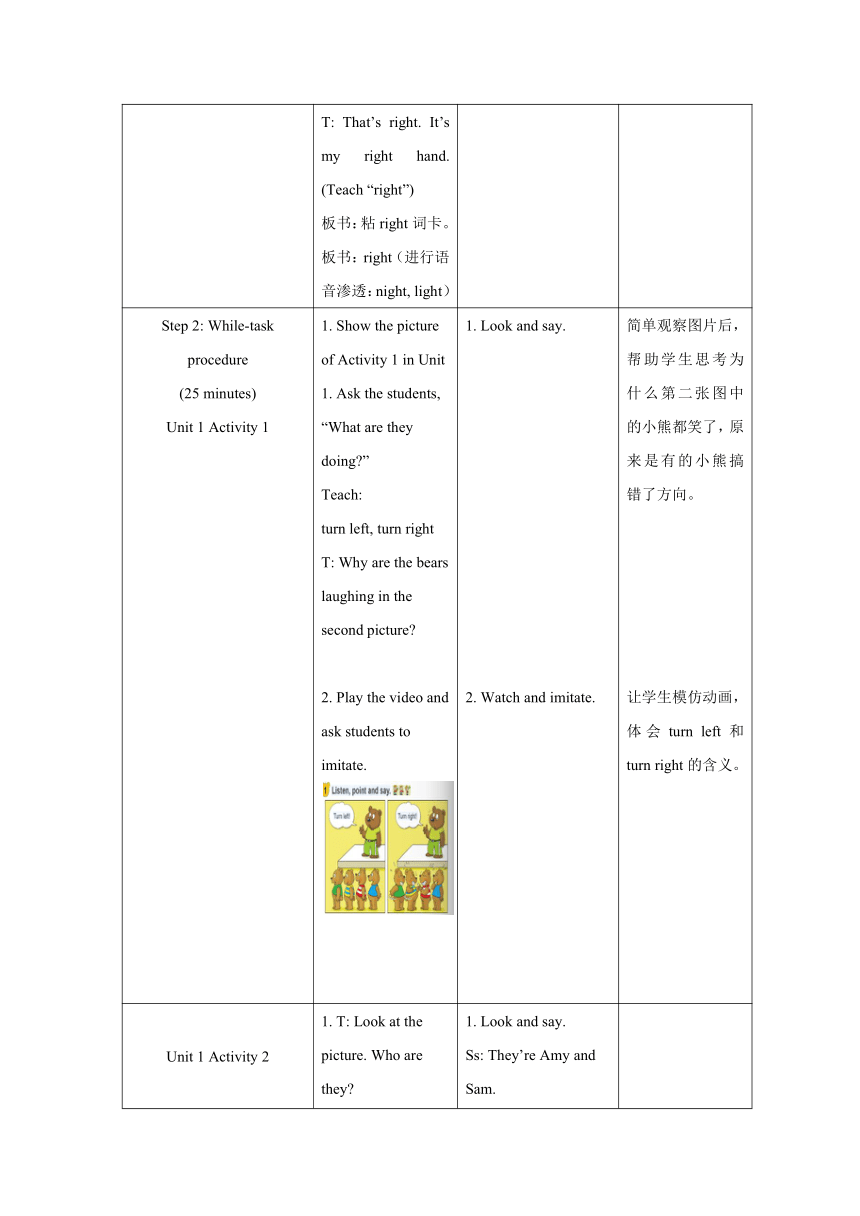小学英语外研版(一年级起点)二年级下册 Module 9 表格式教案(3个课时)
文档属性
| 名称 | 小学英语外研版(一年级起点)二年级下册 Module 9 表格式教案(3个课时) |  | |
| 格式 | docx | ||
| 文件大小 | 1.5MB | ||
| 资源类型 | 教案 | ||
| 版本资源 | 外研版(一年级起点) | ||
| 科目 | 英语 | ||
| 更新时间 | 2022-03-12 22:29:11 | ||
图片预览





文档简介
《英语》(新标准)(小学一起)二年级下册M9教学设计
教材分析 本模块是Module 8知识上的衔接与递进。语用功能是询问和说明路线。怎样运用恰当的、表示指令性动作的语言来描述去往某地的准确路线。熟练使用表示方向的词语在生活中进行交际是学习本课的重点,在讲解学习时加上丰富的练习巩固所学的知识,使学生头脑中形成描述事物的条理性。 Unit 1的课文情境是Sam告诉Amy自己要去位于西湖路的Daming家。Sam并不知道西湖路在哪里,于是他向警察叔叔问路,警察叔叔清楚地告诉他:“向前直走,然后右转,再左转。”Sam走了一会儿,还是没找到Daming家,于是打电话给Daming,Daming告诉Sam,自己住在湖西路,不是西湖路。Sam才发现自己把路名记错了。Unit 2的课文情境是放学的时候Sam问Tingting住在哪儿,Tingting告诉Sam自己住在苹果街,Sam又问苹果街在哪儿,Tingting告诉他出了学校门左转,然后直行,路过工厂,再右转,就是苹果街了。在上一单元,Sam搞错了路名,这次Sam询问了具体路线,相信如果他去Tingting家,一定不会再走错了。 模块核心语言是问路:Excuse me. Where’s... Road Where do you live 指路:Turn left! Turn right! Go straight on! 描述路线:Go out of... 作为热身文本,Unit 1的Activity 1是小熊老师上体育课的内容,呈现核心语言:Turn left! Turn right! Unit 2的Activity 1是小白熊和小黑熊互相询问住在哪里的对话,引出Where do you live I live in/at... 作为练习部分,Unit 1的Activity 4,要求两人一组,一人说指令,一人做动作。 Unit 2 Activity 4是本模块的歌谣部分,Unit 2 Activity 5是学生此前已经开展过的“Simon says”游戏,因此学生应该比较熟悉。就内容看,和Unit 1的文本关系更加密切,所以将其统整在第一课时,帮助学生加深对文本的理解,并为练习核心形容词提供语境。 Unit 2 Activity 6提供了模块的任务语境,引导学生观察图片并理解活动要求:画出自己放学回家的路线图,并向同伴介绍。 本模块的整体教学设计思路是让学生通过第一课时学习Unit 1,包括Unit 1的Activity 1—Activity 4,以及Unit 2的Activity 4和Activity 5;第二课时学习Unit 2,包括Unit 2的Activity 1 —Activity 3,以及绘本内容;第三课时以再构文本为语境,以Unit 2的Activity 6为基础任务进行语言输出。总共通过三个课时逐渐搭建语言框架,内化巩固后进行模块话题directions的输出。
模块教学目标 语言知识目标: 1. 全班学生能在听的过程中从语句中辨别出如下单词:left、go straight on、right、go out of、factory、go past,并书写,掌握其音、义、形。 2. 全班学生能运用Excuse me. Where’s… Road 问路。能用 Turn left! Turn right! Go straight on! Go out of…指路。能用Where do you live 询问居住地点,并进行正确书写。 语言技能目标: 1. 全班学生能在图片的提示下,进行模块的文本表演和复述。 2. 大多数学生能在图片提示下,读懂再构文本。 3. 大多数学生能运用适当的语言解决生活中指路、问路及询问家庭住址的问题,并在相互展示后进行交流和评价。 情感目标: 全班学生能学会寻求他人帮助,关注自己身边的人或与我们的生活相关的事物。 学习策略: 通过观察图片捕捉信息等思维活动,学生进一步养成认知策略;通过了解从学校到家的路线进行课前交流,提高交际策略。 文化意识: 通过学习,增强学生的交通安全意识;在生活中要互相帮助、助人为乐。
教学重点及难点 教学重点:用祈使句指路。 教学难点:方位词的认知与运用。
教学辅助 PPT课件、CD-ROM、学生练习纸
教学策略 思维导图学习法、情境导入法、自然拼读法、任务教学法
教学过程
第一课时教学设计
教材分析 Unit 1:Sam告诉Amy自己要去位于西湖路的Daming家。Sam并不知道西湖路在哪里,于是他向警察叔叔问路,警察叔叔清楚地告诉他:“向前直走,然后右转,再左转。”Sam走了一会儿,还是没找到Daming家,于是打电话给Daming,Daming告诉Sam,自己住在湖西路,不是西湖路。Sam才发现自己把路名记错了。本课时通过对话课教学,学生学习警察叔叔为Sam指路这个文本,能运用核心语言Excuse me. Where’s… Road Turn left! Turn right! Go straight on!和核心词汇left、right、straight相互交流来传递信息,从而学会在现实生活中问路及辨别方向,为第二单元的路线描述作铺垫,实现学会问路指路这一语用功能。
课时教学目标 知识目标: 1. 全班学生能听说读写并在情境中运用词汇:left、go straight on、right。 2. 全班学生能朗读对话,听说认读:Turn left! Turn right! Go straight on! 技能目标: 1. 全班学生能理解对话大意,并能正确朗读模仿和表演对话。 2. 大多数学生能进行小组活动,借助思维导图进行拓展阅读。 情感目标: 能学会寻求他人帮助,准确表达自己的想法。
教学重点与难点 教学重点: 词汇left、go straight on、right的音、义、形;对路线的描述。 教学难点: 正确掌握straight的读音;能借助思维导图梳理如何描述路线。
教学辅助 PPT课件、CD-ROM、词卡、学生课前准备的路线图
教学策略 思维导图学习法、自然拼读法、任务教学法
教学内容 教学活动 设计意图
教师活动 学生活动
Step 1: Pre-task preparation (3 minutes) Enjoy a song TPR 1. Play a song. T: First, I sing a song for you. Now look at me carefully. Let’s enjoy it. T: What can you hear in the song 2. Free talk. T: Hello, boys and girls. Show me your hands. (举起左手) This is my left hand. Follow me: left hand, left, left. (Teach “left”) 板书:粘left词卡。 (举起右手) T: Is this my left hand Ss: No. T: That’s right. It’s my right hand. (Teach “right”) 板书:粘right词卡。 板书:right(进行语音渗透:night, light) 1. Listen and sing. 2. Free talk. 用歌曲导入,欢快的歌曲很容易抓住学生的注意力。训练学生通过听力捕捉信息的能力。借助歌曲的语境,激活旧知,使学生对问路及辨别方向有了初步的了解,可以说是学习本课的前奏。 学生跟教师边说短语,边做动作,在说说做做的同时,轻松愉快地对单词left、right进行了练习,培养了学生的发散性思维的能力。
Step 2: While-task procedure (25 minutes) Unit 1 Activity 1 1. Show the picture of Activity 1 in Unit 1. Ask the students, “What are they doing ” Teach: turn left, turn right T: Why are the bears laughing in the second picture 2. Play the video and ask students to imitate. 1. Look and say. 2. Watch and imitate. 简单观察图片后,帮助学生思考为什么第二张图中的小熊都笑了,原来是有的小熊搞错了方向。 让学生模仿动画,体会turn left和turn right的含义。
Unit 1 Activity 2 1. T: Look at the picture. Who are they 2. Listen to the dialogue step by step. T: They’re talking. Amy asks Sam a question, “Where are you going ” Let’s listen and choose. T: Where is Daming’s home It’s in Xihu Road. (Show the card of “Xihu Road” and read it) T: Where is Xihu Road Sam doesn’t know the way. So he needs help. He asks a policeman. What does Sam ask Listen carefully. “Excuse me. Where’s Xihu Road ” (Teach “Excuse me”) T: Oh, where’s Xihu Road Look, this is a map. Please listen! How to get there T: Let’s learn the way together! “Go straight on!” What’s the meaning (用手势帮助学生理解) (Teach “go straight on”) Show three pictures and practise “Go straight on!” T: Then Then turn right! (Teach “Turn right!”) T: Then Then turn left! (Teach “Turn left!”) T: Now, Sam knows the route. Let’s go with Sam. T: Now, children. Let’s practise. I’m Sam. I’m going to Xihu Road. Can you help me T: Oh, Sam is in Xihu Road. Is Daming’s home in Xihu Road Listen carefully! (Teach “Huxi Road”) T: So Sam is lost. Now listen and circle “go straight on, turn right, turn left”. Ask students to work in groups and act out. 1. Look and say. Ss: They’re Amy and Sam. Listen and choose. Listen and say. Listen and say. Listen carefully. Learn “go straight on”. Look and say. Learn “turn right”. Learn “turn left”. Tell how to get to Xihu Road. T: Excuse me. Where’s Xihu Road Ss: Go straight on! Then turn right! Then turn left! T: Thank you! Ss: You’re welcome! Listen and answer. Ss: No. It’s in Huxi Road. Not Xihu Road. Listen and circle “go straight on, turn right, turn left”. Work in groups and act out. 通过分解课文,逐步学习课文重点词句,并操练。 教师可以对学生进行安全教育,外出的时候最好和大人一起,尽量不要独自一人,如果遇到困难可以找警察。 学生积极踊跃地跟着老师学做动作,既吸引了他们的注意力,又对go straight on, turn right, turn left进行了针对训练。 通过与老师的角色扮演,整体感知如何描述去某地的路线。 巩固本课重点。 通过表演进行文本复述,强化对课文的理解。
Drills about the text 1. Ask students to do as the teacher says. T: Turn left! Turn right! Then practise in pairs. 2. Find food for the rabbit. Ask some volunteers to give directions. T: There is a rabbit. It can’t find the food. Now, I’m the rabbit.Ican’t find my carrot. Hide it. Are you ready 1. Do as the teacher says. Practise in pairs. 2. Hide the carrot. Then give directions and help the rabbit (the teacher) find the carrot. 通过师生演示、生生展示等活动,强化了学生对turn left、turn right词组的理解,并提高学生自主学习、自主练习的能力。 本环节是一个趣味游戏,帮助学生进一步复习巩固所学短语,寓教于乐、提高课堂效率。
Step 3: Post-task activities (11 minutes) 1. Give directions. T: Qingdao is a beautiful city. Many foreigners are visiting Qingdao. But they don’t know the route, so they ask a policeman. The teacher shows how to do it first. 2. Say what the signs mean. 1. Act in pairs and practise asking and giving directions. 2. Look and say. 通过图片说出一些短语能充分发展学生的综合语言运用能力、表达能力,是语言能进一步学以致用的关键之一,二年级的学生在通过自己的努力说出了本课所学的短语,对于他们来说是一个不小的收获,这样他们的学习自信心将会有很大的提高,学习的积极兴趣得到了正面的引导,形成了正确的学习策略和方向,为他们以后的学习打下良好基础,为以后表达作好铺垫。
Step 4: Sum up (1 minute) 1. 引导学生增强交通安全意识; 2. 引导学生自主总结本课的重点词句。 在总结本课知识点前,教师可以对学生进行安全教育。并通过板书的思维导图再次回顾重点词句,整体关注话题点——如何指路,明确本课时话题。引导学生思考和体会:仔细观察,你会发现更多。
Classroom Assessment 教师口头评价; 能否用2-3句描述从家到学校的路线,完成本课时任务。 学习过程即时评价,通过口头评价及任务输出,观察反馈学生对本课时的目标达成情况。
家庭作业: 1. Listen and read the dialogue 5 times. 2. Draw and describe the route from your home to your school.
板书设计: Module 9 Unit 1 Turn left! Turn left! Turn right! Go straight on!
第二课时教学设计
教材分析 Unit 2:放学的时候Sam问Tingting住在哪儿,Tingting告诉Sam自己住在苹果街,Sam又问苹果街在哪儿,Tingting告诉他出了学校门左转,然后直行,路过工厂,再右转,就是苹果街了。在上一单元,Sam搞错了路名,这次Sam询问了具体路线,相信如果他去Tingting家,一定不会再走错了。核心语言是Where do you live I live… Go out of… go past
课时教学目标 知识目标: 1. 全班学生能听说读并在情境中运用词汇:go out of、factory、go past 2. 全班学生能朗读文本,听说认读Go out of…。能用Where do you live 询问居住地点,大多数学生能在情景表演中描述某条路线,完成P54A3。 技能目标: 1. 全班学生能理解语篇大意,看图描述文本。 2. 大多数学生能在路线图的提示和老师的帮助下进行小组活动,描述某条路线。 3. 大多数学生能感知绘本内容和情感,通过小组活动,回顾绘本进行填空练习,培养合作与探究的能力。 情感目标: 通过询问方位,介绍路线培养学生独立解决问题的能力和乐于助人的品质。
教学重点与难点 教学重点: 词汇out、factory的音、义、形。对路线的描述。 教学难点: 根据路线图进行简单的方位描述。
教学辅助 PPT课件、CD-ROM、学生练习纸
教学策略 通过图片或关键词,复述文本;通过活动用书的听力练习和绘本阅读,描述路线图,循环练习,强化语言框架。
教学内容(含时间设置) 教学活动 设计意图
教师活动 学生活动
Step 1: Pre-task preparation (5 minutes) Review Unit 1 Give directions. T: Turn left. Turn right. Go straight on. Do as the teacher says. 通过TPR活动,引导学生复习Unit 1课文和方位词,反馈复现第一课时内容。
Step 2: While-task procedure (20 minutes) Teach Unit 2 1. Show the picture of Unit 2 Activity 1 and play the video. T: Where does the white bear live Where does the black bear live 2. Ask students where they live. T: I live in… Where do you live 3. Play the CD-ROM. Listen and answer. T: Look at this girl. Her name is Tingting. Can you answer these questions: Where does she live Where is Apple Street 4. Play the CD-ROM again. Then draw the route with a partner. 5. Look at the picture. Try to say the route from their school to Tingting’s home. 6. Ask, answer and draw. 7. Retell. 1. Listen and answer. Talk in groups. 2. Talk about hometown. S1: I live in… S2: I live in… 3. Listen and choose. Listen and answer. 4. Look and draw the route. 5. Encourage Ss to say. 6. Ask, answer and draw. 7. Retell the text according to the key words on the blackboard. 观察文本图片,学生通过讨论初步感知图片信息,预测文本内容。 将课本主要句型与学生的生活联系起来,不但增加了趣味性,更使学习内容可以学以致用,而且环节之间过渡自然。 通过板书呈现一系列主要动词词组go out of… go past…,提供语言框架,学生进一步感知思维导图的形成过程。 绘制路线图,在语境中集中练习本课重点句型。 通过板书的关键词,进一步训练根据语言框架复述文本的能力。
Drillings about the text 1. Let the students do exercises about the route in Activity Book. 2. Let the students talk about the route. 1. Listen and write. a. Ask and answer. b. Check in pairs. 2. Talk in pairs about the route. 充分利用活动用书上的练习,创设了一个情境,延长练习的韧性——学生通过听音做动作,提高听力;通过答案反馈,进行口语练习。 从图片延伸自己家路线的问答及相应的描述,让语言运用更加真实。运用重点句型和数字,并以学生实际的路线进行提问和回答。
Step 3: Post-task activities (14 minutes) Look and say Find another route to the place. Draw it and then tell a partner. Talk in pairs. 让学生在真实的任务活动中运用本节课所学的内容。
Step 4: Sum up (1 minute) T: What did you learn today 通过教师引导,学生自主总结,构建自己的知识框架。
Classroom Assessment 教师口头评价; 能否用2-3句描述某条路线,完成本课时任务。 通过口头评价及任务输出,观察反馈学生对本课时的目标达成情况,学生逐步建立用地图描述路线的语言框架,为下课时的目标达成作铺垫。
家庭作业: 1. Listen and read the dialogue 5 times. 2. Try to say the route from your home to your school.
板书设计: Module 9 Unit 2 Where do you live Where do you live I live in… Go out of… Turn… Then…
第三课时教学设计
教材分析 学生通过学习本模块的前两课时已经能够运用恰当的指令性动作的语言来询问和说明路线。 本课时通过复现重点词句,复习有关指令性动作的语言知识。通过表演激发学生学习兴趣,低年级学生通过边说边做的形式加深对知识的理解。
课时教学目标 语言知识目标: 1. 全班学生能听说读并在情境中运用词汇:left、go straight on、right、go out of、factory、go past。 2. 全班学生能运用Excuse me. Where’s… 问路。能用 Turn left! Turn right! Go straight on! Go out of…指路。能用Where do you live 询问居住地点,并进行正确书写。 语言技能目标: 1. 全班学生能在图片的提示下,进行模块的文本表演和复述。 2. 大多数学生能看地图用适当的语言进行指路。 情感目标: 全班学生能学会寻求他人帮助,关注自己身边的人或与我们的生活相关的事物。
教学重点与难点 教学重点:用指令性动作的语言来询问和说明路线。 教学难点:方位词的认知和应用。
教学辅助 PPT课件、CD-ROM
教学策略 通过表演、复述,复习模块文本; 通过制作路线图及看图说话进行简单的路线描述。
教学内容(含时间设置) 教学活动 设计意图
教师活动 学生活动
Step 1: Pre-task preparation (15 minutes) 1. Listen and say. Then chant. 2. Look and say. Tell what the signs mean. 3. Let the students act out the dialogues of Unit 1 and Unit 2. 1. Do as they chant. 2. Look and say. 3. Retell the dialogues of Unit1 and Unit 2. 歌谣热身,调动学生的学习兴趣,并在歌谣中复习前两课的知识点。 通过复习文本,反馈前两课时的掌握情况,复现文本核心语言。
Step 2: While-task procedure (20 minutes) 1. Ask students to work in groups. One gives commands and the others do. Then show in class. 2. Look at the simple map on the board. Ask students to ask and answer how to get to a place. Students should work in pairs. 1. Work in groups. Listen and do. 2. Take turns to ask and answer how to get to a place. 将自主学习在课内进行,发挥学生的自主性。 通过借助地图,来对方位词及路线进行巩固,学生的观察力及语言表达能力会进一步提升。
Step 3: Post-task activities (4 minutes) 1. Feedback of yesterday’s homework. 1. Show the students’ homework. Then correct someone’s homework in class. 2. Ask and answer. Let the students say the route. 1. Yesterday’s homework show. 2. Say the route. 教师通过对个体作业的纠错,让学生关注到书面表达中容易出现的问题。 通过教师问学生答的方式,操练描述方向的语句。
Step 4: Sum up (1 minute) T: When we don’t know how to get to a place, what should we do 通过学生自己总结,观察他们是否能够总结出语言知识点,并体会梳理本模块的学习话题。
Classroom Assessment 教师口头评价; 当堂修改学生作业中的错误,反馈书写情况; 能否内化描述路线的要素,用4-5句进行正确书写。
家庭作业: 1. Read the two texts. 2. Talk about how to get to your home from school with a friend.
板书设计: Module 9 Directions Where do you live I live in…
教材分析 本模块是Module 8知识上的衔接与递进。语用功能是询问和说明路线。怎样运用恰当的、表示指令性动作的语言来描述去往某地的准确路线。熟练使用表示方向的词语在生活中进行交际是学习本课的重点,在讲解学习时加上丰富的练习巩固所学的知识,使学生头脑中形成描述事物的条理性。 Unit 1的课文情境是Sam告诉Amy自己要去位于西湖路的Daming家。Sam并不知道西湖路在哪里,于是他向警察叔叔问路,警察叔叔清楚地告诉他:“向前直走,然后右转,再左转。”Sam走了一会儿,还是没找到Daming家,于是打电话给Daming,Daming告诉Sam,自己住在湖西路,不是西湖路。Sam才发现自己把路名记错了。Unit 2的课文情境是放学的时候Sam问Tingting住在哪儿,Tingting告诉Sam自己住在苹果街,Sam又问苹果街在哪儿,Tingting告诉他出了学校门左转,然后直行,路过工厂,再右转,就是苹果街了。在上一单元,Sam搞错了路名,这次Sam询问了具体路线,相信如果他去Tingting家,一定不会再走错了。 模块核心语言是问路:Excuse me. Where’s... Road Where do you live 指路:Turn left! Turn right! Go straight on! 描述路线:Go out of... 作为热身文本,Unit 1的Activity 1是小熊老师上体育课的内容,呈现核心语言:Turn left! Turn right! Unit 2的Activity 1是小白熊和小黑熊互相询问住在哪里的对话,引出Where do you live I live in/at... 作为练习部分,Unit 1的Activity 4,要求两人一组,一人说指令,一人做动作。 Unit 2 Activity 4是本模块的歌谣部分,Unit 2 Activity 5是学生此前已经开展过的“Simon says”游戏,因此学生应该比较熟悉。就内容看,和Unit 1的文本关系更加密切,所以将其统整在第一课时,帮助学生加深对文本的理解,并为练习核心形容词提供语境。 Unit 2 Activity 6提供了模块的任务语境,引导学生观察图片并理解活动要求:画出自己放学回家的路线图,并向同伴介绍。 本模块的整体教学设计思路是让学生通过第一课时学习Unit 1,包括Unit 1的Activity 1—Activity 4,以及Unit 2的Activity 4和Activity 5;第二课时学习Unit 2,包括Unit 2的Activity 1 —Activity 3,以及绘本内容;第三课时以再构文本为语境,以Unit 2的Activity 6为基础任务进行语言输出。总共通过三个课时逐渐搭建语言框架,内化巩固后进行模块话题directions的输出。
模块教学目标 语言知识目标: 1. 全班学生能在听的过程中从语句中辨别出如下单词:left、go straight on、right、go out of、factory、go past,并书写,掌握其音、义、形。 2. 全班学生能运用Excuse me. Where’s… Road 问路。能用 Turn left! Turn right! Go straight on! Go out of…指路。能用Where do you live 询问居住地点,并进行正确书写。 语言技能目标: 1. 全班学生能在图片的提示下,进行模块的文本表演和复述。 2. 大多数学生能在图片提示下,读懂再构文本。 3. 大多数学生能运用适当的语言解决生活中指路、问路及询问家庭住址的问题,并在相互展示后进行交流和评价。 情感目标: 全班学生能学会寻求他人帮助,关注自己身边的人或与我们的生活相关的事物。 学习策略: 通过观察图片捕捉信息等思维活动,学生进一步养成认知策略;通过了解从学校到家的路线进行课前交流,提高交际策略。 文化意识: 通过学习,增强学生的交通安全意识;在生活中要互相帮助、助人为乐。
教学重点及难点 教学重点:用祈使句指路。 教学难点:方位词的认知与运用。
教学辅助 PPT课件、CD-ROM、学生练习纸
教学策略 思维导图学习法、情境导入法、自然拼读法、任务教学法
教学过程
第一课时教学设计
教材分析 Unit 1:Sam告诉Amy自己要去位于西湖路的Daming家。Sam并不知道西湖路在哪里,于是他向警察叔叔问路,警察叔叔清楚地告诉他:“向前直走,然后右转,再左转。”Sam走了一会儿,还是没找到Daming家,于是打电话给Daming,Daming告诉Sam,自己住在湖西路,不是西湖路。Sam才发现自己把路名记错了。本课时通过对话课教学,学生学习警察叔叔为Sam指路这个文本,能运用核心语言Excuse me. Where’s… Road Turn left! Turn right! Go straight on!和核心词汇left、right、straight相互交流来传递信息,从而学会在现实生活中问路及辨别方向,为第二单元的路线描述作铺垫,实现学会问路指路这一语用功能。
课时教学目标 知识目标: 1. 全班学生能听说读写并在情境中运用词汇:left、go straight on、right。 2. 全班学生能朗读对话,听说认读:Turn left! Turn right! Go straight on! 技能目标: 1. 全班学生能理解对话大意,并能正确朗读模仿和表演对话。 2. 大多数学生能进行小组活动,借助思维导图进行拓展阅读。 情感目标: 能学会寻求他人帮助,准确表达自己的想法。
教学重点与难点 教学重点: 词汇left、go straight on、right的音、义、形;对路线的描述。 教学难点: 正确掌握straight的读音;能借助思维导图梳理如何描述路线。
教学辅助 PPT课件、CD-ROM、词卡、学生课前准备的路线图
教学策略 思维导图学习法、自然拼读法、任务教学法
教学内容 教学活动 设计意图
教师活动 学生活动
Step 1: Pre-task preparation (3 minutes) Enjoy a song TPR 1. Play a song. T: First, I sing a song for you. Now look at me carefully. Let’s enjoy it. T: What can you hear in the song 2. Free talk. T: Hello, boys and girls. Show me your hands. (举起左手) This is my left hand. Follow me: left hand, left, left. (Teach “left”) 板书:粘left词卡。 (举起右手) T: Is this my left hand Ss: No. T: That’s right. It’s my right hand. (Teach “right”) 板书:粘right词卡。 板书:right(进行语音渗透:night, light) 1. Listen and sing. 2. Free talk. 用歌曲导入,欢快的歌曲很容易抓住学生的注意力。训练学生通过听力捕捉信息的能力。借助歌曲的语境,激活旧知,使学生对问路及辨别方向有了初步的了解,可以说是学习本课的前奏。 学生跟教师边说短语,边做动作,在说说做做的同时,轻松愉快地对单词left、right进行了练习,培养了学生的发散性思维的能力。
Step 2: While-task procedure (25 minutes) Unit 1 Activity 1 1. Show the picture of Activity 1 in Unit 1. Ask the students, “What are they doing ” Teach: turn left, turn right T: Why are the bears laughing in the second picture 2. Play the video and ask students to imitate. 1. Look and say. 2. Watch and imitate. 简单观察图片后,帮助学生思考为什么第二张图中的小熊都笑了,原来是有的小熊搞错了方向。 让学生模仿动画,体会turn left和turn right的含义。
Unit 1 Activity 2 1. T: Look at the picture. Who are they 2. Listen to the dialogue step by step. T: They’re talking. Amy asks Sam a question, “Where are you going ” Let’s listen and choose. T: Where is Daming’s home It’s in Xihu Road. (Show the card of “Xihu Road” and read it) T: Where is Xihu Road Sam doesn’t know the way. So he needs help. He asks a policeman. What does Sam ask Listen carefully. “Excuse me. Where’s Xihu Road ” (Teach “Excuse me”) T: Oh, where’s Xihu Road Look, this is a map. Please listen! How to get there T: Let’s learn the way together! “Go straight on!” What’s the meaning (用手势帮助学生理解) (Teach “go straight on”) Show three pictures and practise “Go straight on!” T: Then Then turn right! (Teach “Turn right!”) T: Then Then turn left! (Teach “Turn left!”) T: Now, Sam knows the route. Let’s go with Sam. T: Now, children. Let’s practise. I’m Sam. I’m going to Xihu Road. Can you help me T: Oh, Sam is in Xihu Road. Is Daming’s home in Xihu Road Listen carefully! (Teach “Huxi Road”) T: So Sam is lost. Now listen and circle “go straight on, turn right, turn left”. Ask students to work in groups and act out. 1. Look and say. Ss: They’re Amy and Sam. Listen and choose. Listen and say. Listen and say. Listen carefully. Learn “go straight on”. Look and say. Learn “turn right”. Learn “turn left”. Tell how to get to Xihu Road. T: Excuse me. Where’s Xihu Road Ss: Go straight on! Then turn right! Then turn left! T: Thank you! Ss: You’re welcome! Listen and answer. Ss: No. It’s in Huxi Road. Not Xihu Road. Listen and circle “go straight on, turn right, turn left”. Work in groups and act out. 通过分解课文,逐步学习课文重点词句,并操练。 教师可以对学生进行安全教育,外出的时候最好和大人一起,尽量不要独自一人,如果遇到困难可以找警察。 学生积极踊跃地跟着老师学做动作,既吸引了他们的注意力,又对go straight on, turn right, turn left进行了针对训练。 通过与老师的角色扮演,整体感知如何描述去某地的路线。 巩固本课重点。 通过表演进行文本复述,强化对课文的理解。
Drills about the text 1. Ask students to do as the teacher says. T: Turn left! Turn right! Then practise in pairs. 2. Find food for the rabbit. Ask some volunteers to give directions. T: There is a rabbit. It can’t find the food. Now, I’m the rabbit.Ican’t find my carrot. Hide it. Are you ready 1. Do as the teacher says. Practise in pairs. 2. Hide the carrot. Then give directions and help the rabbit (the teacher) find the carrot. 通过师生演示、生生展示等活动,强化了学生对turn left、turn right词组的理解,并提高学生自主学习、自主练习的能力。 本环节是一个趣味游戏,帮助学生进一步复习巩固所学短语,寓教于乐、提高课堂效率。
Step 3: Post-task activities (11 minutes) 1. Give directions. T: Qingdao is a beautiful city. Many foreigners are visiting Qingdao. But they don’t know the route, so they ask a policeman. The teacher shows how to do it first. 2. Say what the signs mean. 1. Act in pairs and practise asking and giving directions. 2. Look and say. 通过图片说出一些短语能充分发展学生的综合语言运用能力、表达能力,是语言能进一步学以致用的关键之一,二年级的学生在通过自己的努力说出了本课所学的短语,对于他们来说是一个不小的收获,这样他们的学习自信心将会有很大的提高,学习的积极兴趣得到了正面的引导,形成了正确的学习策略和方向,为他们以后的学习打下良好基础,为以后表达作好铺垫。
Step 4: Sum up (1 minute) 1. 引导学生增强交通安全意识; 2. 引导学生自主总结本课的重点词句。 在总结本课知识点前,教师可以对学生进行安全教育。并通过板书的思维导图再次回顾重点词句,整体关注话题点——如何指路,明确本课时话题。引导学生思考和体会:仔细观察,你会发现更多。
Classroom Assessment 教师口头评价; 能否用2-3句描述从家到学校的路线,完成本课时任务。 学习过程即时评价,通过口头评价及任务输出,观察反馈学生对本课时的目标达成情况。
家庭作业: 1. Listen and read the dialogue 5 times. 2. Draw and describe the route from your home to your school.
板书设计: Module 9 Unit 1 Turn left! Turn left! Turn right! Go straight on!
第二课时教学设计
教材分析 Unit 2:放学的时候Sam问Tingting住在哪儿,Tingting告诉Sam自己住在苹果街,Sam又问苹果街在哪儿,Tingting告诉他出了学校门左转,然后直行,路过工厂,再右转,就是苹果街了。在上一单元,Sam搞错了路名,这次Sam询问了具体路线,相信如果他去Tingting家,一定不会再走错了。核心语言是Where do you live I live… Go out of… go past
课时教学目标 知识目标: 1. 全班学生能听说读并在情境中运用词汇:go out of、factory、go past 2. 全班学生能朗读文本,听说认读Go out of…。能用Where do you live 询问居住地点,大多数学生能在情景表演中描述某条路线,完成P54A3。 技能目标: 1. 全班学生能理解语篇大意,看图描述文本。 2. 大多数学生能在路线图的提示和老师的帮助下进行小组活动,描述某条路线。 3. 大多数学生能感知绘本内容和情感,通过小组活动,回顾绘本进行填空练习,培养合作与探究的能力。 情感目标: 通过询问方位,介绍路线培养学生独立解决问题的能力和乐于助人的品质。
教学重点与难点 教学重点: 词汇out、factory的音、义、形。对路线的描述。 教学难点: 根据路线图进行简单的方位描述。
教学辅助 PPT课件、CD-ROM、学生练习纸
教学策略 通过图片或关键词,复述文本;通过活动用书的听力练习和绘本阅读,描述路线图,循环练习,强化语言框架。
教学内容(含时间设置) 教学活动 设计意图
教师活动 学生活动
Step 1: Pre-task preparation (5 minutes) Review Unit 1 Give directions. T: Turn left. Turn right. Go straight on. Do as the teacher says. 通过TPR活动,引导学生复习Unit 1课文和方位词,反馈复现第一课时内容。
Step 2: While-task procedure (20 minutes) Teach Unit 2 1. Show the picture of Unit 2 Activity 1 and play the video. T: Where does the white bear live Where does the black bear live 2. Ask students where they live. T: I live in… Where do you live 3. Play the CD-ROM. Listen and answer. T: Look at this girl. Her name is Tingting. Can you answer these questions: Where does she live Where is Apple Street 4. Play the CD-ROM again. Then draw the route with a partner. 5. Look at the picture. Try to say the route from their school to Tingting’s home. 6. Ask, answer and draw. 7. Retell. 1. Listen and answer. Talk in groups. 2. Talk about hometown. S1: I live in… S2: I live in… 3. Listen and choose. Listen and answer. 4. Look and draw the route. 5. Encourage Ss to say. 6. Ask, answer and draw. 7. Retell the text according to the key words on the blackboard. 观察文本图片,学生通过讨论初步感知图片信息,预测文本内容。 将课本主要句型与学生的生活联系起来,不但增加了趣味性,更使学习内容可以学以致用,而且环节之间过渡自然。 通过板书呈现一系列主要动词词组go out of… go past…,提供语言框架,学生进一步感知思维导图的形成过程。 绘制路线图,在语境中集中练习本课重点句型。 通过板书的关键词,进一步训练根据语言框架复述文本的能力。
Drillings about the text 1. Let the students do exercises about the route in Activity Book. 2. Let the students talk about the route. 1. Listen and write. a. Ask and answer. b. Check in pairs. 2. Talk in pairs about the route. 充分利用活动用书上的练习,创设了一个情境,延长练习的韧性——学生通过听音做动作,提高听力;通过答案反馈,进行口语练习。 从图片延伸自己家路线的问答及相应的描述,让语言运用更加真实。运用重点句型和数字,并以学生实际的路线进行提问和回答。
Step 3: Post-task activities (14 minutes) Look and say Find another route to the place. Draw it and then tell a partner. Talk in pairs. 让学生在真实的任务活动中运用本节课所学的内容。
Step 4: Sum up (1 minute) T: What did you learn today 通过教师引导,学生自主总结,构建自己的知识框架。
Classroom Assessment 教师口头评价; 能否用2-3句描述某条路线,完成本课时任务。 通过口头评价及任务输出,观察反馈学生对本课时的目标达成情况,学生逐步建立用地图描述路线的语言框架,为下课时的目标达成作铺垫。
家庭作业: 1. Listen and read the dialogue 5 times. 2. Try to say the route from your home to your school.
板书设计: Module 9 Unit 2 Where do you live Where do you live I live in… Go out of… Turn… Then…
第三课时教学设计
教材分析 学生通过学习本模块的前两课时已经能够运用恰当的指令性动作的语言来询问和说明路线。 本课时通过复现重点词句,复习有关指令性动作的语言知识。通过表演激发学生学习兴趣,低年级学生通过边说边做的形式加深对知识的理解。
课时教学目标 语言知识目标: 1. 全班学生能听说读并在情境中运用词汇:left、go straight on、right、go out of、factory、go past。 2. 全班学生能运用Excuse me. Where’s… 问路。能用 Turn left! Turn right! Go straight on! Go out of…指路。能用Where do you live 询问居住地点,并进行正确书写。 语言技能目标: 1. 全班学生能在图片的提示下,进行模块的文本表演和复述。 2. 大多数学生能看地图用适当的语言进行指路。 情感目标: 全班学生能学会寻求他人帮助,关注自己身边的人或与我们的生活相关的事物。
教学重点与难点 教学重点:用指令性动作的语言来询问和说明路线。 教学难点:方位词的认知和应用。
教学辅助 PPT课件、CD-ROM
教学策略 通过表演、复述,复习模块文本; 通过制作路线图及看图说话进行简单的路线描述。
教学内容(含时间设置) 教学活动 设计意图
教师活动 学生活动
Step 1: Pre-task preparation (15 minutes) 1. Listen and say. Then chant. 2. Look and say. Tell what the signs mean. 3. Let the students act out the dialogues of Unit 1 and Unit 2. 1. Do as they chant. 2. Look and say. 3. Retell the dialogues of Unit1 and Unit 2. 歌谣热身,调动学生的学习兴趣,并在歌谣中复习前两课的知识点。 通过复习文本,反馈前两课时的掌握情况,复现文本核心语言。
Step 2: While-task procedure (20 minutes) 1. Ask students to work in groups. One gives commands and the others do. Then show in class. 2. Look at the simple map on the board. Ask students to ask and answer how to get to a place. Students should work in pairs. 1. Work in groups. Listen and do. 2. Take turns to ask and answer how to get to a place. 将自主学习在课内进行,发挥学生的自主性。 通过借助地图,来对方位词及路线进行巩固,学生的观察力及语言表达能力会进一步提升。
Step 3: Post-task activities (4 minutes) 1. Feedback of yesterday’s homework. 1. Show the students’ homework. Then correct someone’s homework in class. 2. Ask and answer. Let the students say the route. 1. Yesterday’s homework show. 2. Say the route. 教师通过对个体作业的纠错,让学生关注到书面表达中容易出现的问题。 通过教师问学生答的方式,操练描述方向的语句。
Step 4: Sum up (1 minute) T: When we don’t know how to get to a place, what should we do 通过学生自己总结,观察他们是否能够总结出语言知识点,并体会梳理本模块的学习话题。
Classroom Assessment 教师口头评价; 当堂修改学生作业中的错误,反馈书写情况; 能否内化描述路线的要素,用4-5句进行正确书写。
家庭作业: 1. Read the two texts. 2. Talk about how to get to your home from school with a friend.
板书设计: Module 9 Directions Where do you live I live in…
同课章节目录
- Module 1
- Unit 1 What's the weather like ?
- Unit 2 I like swimming.
- Module 2
- Unit 1She's listening to the radio.
- Unit 2 I'm drawing a picture.
- Module 3
- Unit 1 Sam isn't tidying his room.
- Unit 2 Are you doing your homework?
- Module 4
- Unit 1 What are you doing ?
- Unit 2 What's he doing?
- Module 5
- Unit 1 Lingling is skipping.
- Unit 2 What are the kids playing?
- Module 6
- Unit 1 I usually play basketball.
- Unit 2 My grandma usually cooks.
- Module 7
- Unit 1 It's Children's Day today.
- Unit 2 We're having a picnic.
- Module 8
- Unit 1 The train is going up a hill.
- Unit 2 The horse is turning around.
- Module 9
- Unit 1 Turn left!
- Unit 2 Where do you live ?
- Module 10
- Unit 1 It's next to the park.
- Unit 2 He's helping a child.
- Review Module
- Unit 1
- Unit 2
